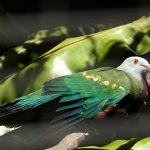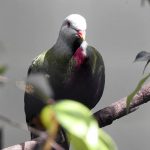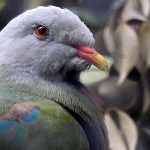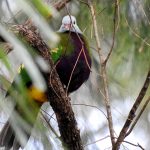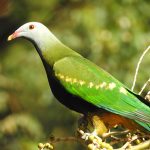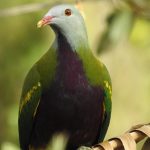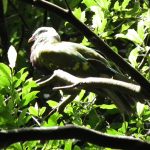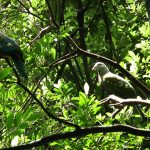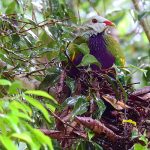WOMPOO FRUIT-DOVE
Jewel of Australia’s Rainforests
Deep within the lush, emerald canopies of Australia’s eastern rainforests lives a bird so striking, it seems almost touched by the brush of an artist. Measuring up to 45 centimetres in length, the Wompoo Fruit-dove is not only the largest of Australia’s fruit-doves, but also one of the most captivating. With its brilliant tapestry of colours and soft, resonant call, the Wompoo tells the story of ancient forests, ecological connectivity, and the delicate balance upon which Australia’s biodiversity rests.
Discovering the Wompoo
A Living Palette
Imagine stepping beneath the cool, dappled shade of a subtropical rainforest. Overhead, a flash of emerald ripples across the green—a bird with a royal purple chest, gold-blushed belly, and a striking yellow wing-bar. Its head is a gentle grey, the bill tinged orange with a yellow tip, and eyes glowing a deep sunset hue. Every feature of the Wompoo Fruit-dove is vivid, yet harmoniously woven into the rich greens and browns of the rainforest.
Adults and juveniles differ subtly: the young are duller, with more green in their plumage, blending easily into the foliage.
Ecology and Behaviour
The Great Frugivore
The air in the rainforest is scented sweetly by ripening fruit. The Wompoo is an obligate frugivore, thriving on a wide variety of rainforest fruits. With a gape much larger than most other frugivorous birds, it is specially equipped to swallow and disperse the seeds of sizeable fruits—making it a crucial player in Australia’s rainforest ecology.
Sensory Snapshot:
- Sight: Watch as the Wompoo moves gracefully, mostly high in the canopy, foraging quietly, yet sometimes descending to lower branches or the forest floor in search of fallen fruit.
- Sound: Listen for the deep, resonant “wollack-wa-hoo” or the softer, namesake “wompoo”—calls that echo through the dense green.
- Touch: Picture the humid air, cool moss beneath towering tree trunks, as these doves glide from fig to palm, their wings flickering in the dim understorey light.
- Smell: Imagine the mingled aroma of loamy earth and fruit, filling the still air with promise of renewal.
Social and Nesting Habits
The Wompoo is mostly seen alone or in pairs, but sometimes small groups gather where fruit is plentiful. Both male and female build a flat, sturdy nest low in the tree, usually between 2 and 10 metres above ground. Only one white egg is laid per breeding attempt, and both parents raise the single chick together.
Migration and Range
Wompoo Fruit-doves move locally rather than over long distances, though there is a seasonal shift: in summer, they ascend to higher elevations; in winter, they descend to feed on fruiting trees in foothills and farmland. Their home range is about 20 hectares during breeding.
Conservation Status
| Threat | Impact | Current Status |
|---|---|---|
| Habitat Fragmentation | High: Dependent on continuous rainforest | Vulnerable (NSW) |
| Clearing for Agriculture | High: Loss of breeding and feeding habitat | Population declining |
| Window Strikes | Medium: Risk in urban areas | Ongoing threat |
| Disturbance (Tourism) | Emerging: Rainforest recreation increases | Requires monitoring |
| Invasive Plants | Low: Wompoo not adapting to exotics | No significant benefit |
Much of the Wompoo’s former range has been lost. Previously stretching from the Illawarra of New South Wales up to the tip of Cape York, the southernmost populations have vanished, primarily due to habitat clearing. Today, the largest populations persist where mature rainforest remains, especially within protected reserves.
Did you know?
In June 2010, the Wompoo Fruit-dove was officially listed as Vulnerable in New South Wales, a recognition of its declining fortunes as forest habitats continue to fragment.
The Wompoo Fruit-dove’s Role in the Rainforest
The Wompoo is more than a beautiful bird—it’s a vital seed disperser. Trees like native figs and laurels depend on frugivores with large gapes to move their seeds across the landscape. Without the Wompoo, many rainforest giants would struggle to regenerate, diminishing the forest’s resilience and diversity.
Human Impact and the Path Forward
The haunting call of the Wompoo, once common across vast expanses of green, is now a more fragile melody. Rainforests are resilient, yet their intricate web of life can be unravelled by fragmentation and loss. Every paddock tree retained, every reserve maintained, and every effort to reconnect habitat corridors can help ensure the Wompoo Fruit-dove remains a living jewel in Australia’s forests.
What Can We Do?
- Support restoration and preservation of native rainforest.
- Reduce habitat fragmentation by maintaining wildlife corridors.
- Choose bird-friendly windows and support local conservation initiatives.
- Visit rainforests responsibly, minimising disturbance to wildlife.
Conclusion: Echoes from the Canopy
The story of the Wompoo Fruit-dove is a lesson in beauty, balance, and partnership. As we listen to its deep, evocative call filtering through the ancient forests, let it remind us: the survival of one stunning bird is connected to the fate of entire landscapes—and the shared future of Australia’s wild places.
Let us keep the forests whole, so that the Wompoo’s colours and calls may fill our awe, our science, and our collective story for generations to come.

